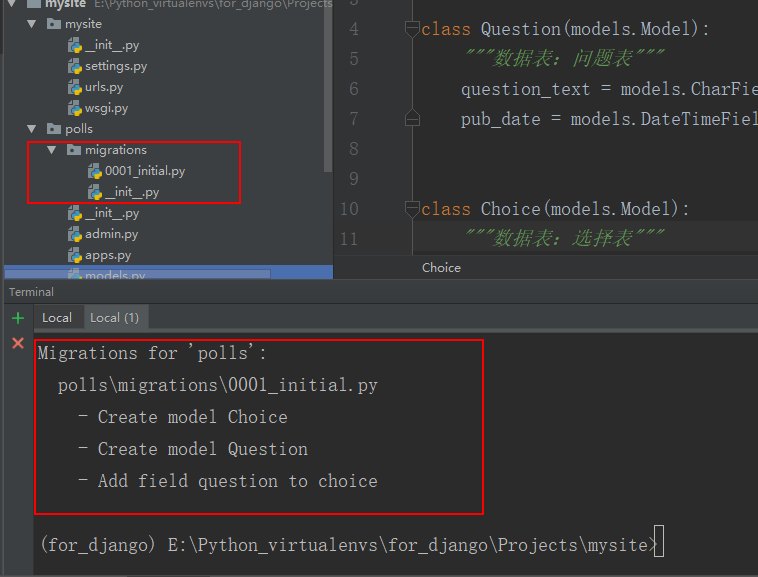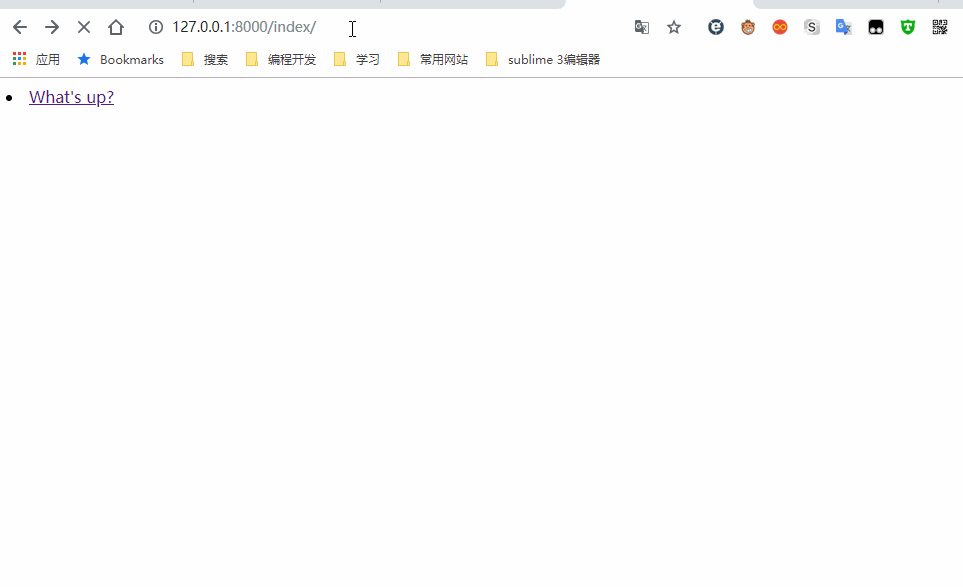秦皇岛网站建设哪家好关键词排名提高方法
1. 创建项目
1.1 新建项目
首先新建一个项目,名为 mysite,命令如下:
django-admin startproject mysite # 或用 django-admin.py
运行成功,生成一些目录:
mysite/manage.py # 管理 Django 项目的命令行工具mysite/ # 包,包含项目__init__.pysettings.py # 配置文件urls.py # 路由文件wsgi.py # WSGI 接口,web 服务器进入点,提供底层网络通信功能,无需关心
1.2 启动服务器
python manage.py runserver # 默认以 8000 端口开启
python manage.py runserver 8080 # 指定端口
执行成功,看到输出如下信息:

在浏览器中访问 http://127.0.0.1:8000/,看到以下信息,表示开启成功(Django2.x 以下版本不一样):

1.3 新建应用
现在我们新建一个应用(app),名为 polls,命令如下:
cd mysite # 切好到项目里面
python manage.py startapp polls
执行成功后,可以看到 mysite 中多了一个 polls文件夹,打开 polls,里面包含以下文件:
polls/__init__.pyadmin.py # Django 提供的后台管理程序apps.py migrations/ # 数据库表生成记录__init__.pymodels.py # 模型(与数据库相关)tests.py # 测试文件views.py # 视图(一个视图函数表示一个页面)
项目与应用的区别
- 一个项目可以有一个或多个应用
- 一个应用往往是用来实现某个功能,如:博客、日程管理系统等
- 一个应用可以属于多个项目
1.4 第一个视图
一个视图函数表示一个 Web 页面,在 polls/views.py 中编写:
from django.shortcuts import render, HttpResponsedef index(request):"""首页"""return HttpResponse('Is Ok!')
要调用视图,我们需要先配置 urlconf,让 Django 找到我们的视图函数,在此之前我们先把 app 添加到 settings.py 中:
INSTALLED_APPS = ['django.contrib.admin','django.contrib.auth','django.contrib.contenttypes','django.contrib.sessions','django.contrib.messages','django.contrib.staticfiles','polls', # 最好空一行,以示区分
]
配置 urlconf
编写 mysite/urls.py:
from django.contrib import admin
from django.urls import path, include
from polls import views # 导入视图函数urlpatterns = [path('admin/', admin.site.urls),path('index/', views.index, name='index'),
]
访问 http://127.0.0.1:8000/index/,如果不出意外的话,会看到 Is Ok! 的字样~
多级路由
上面我们只创建了一个 app,因此 url 路径配置在项目 mysite/urls.py中毫无影响,但是当有多个应用且有多个相同的名字的视图时,为了避免冲突,就需要用到多级路由了。
- 配置
mysite/urls.py:
from django.contrib import admin
from django.urls import path, include # 引入 includeurlpatterns = [path('admin/', admin.site.urls),path('polls/', include('polls.urls')), # include 就相当于多级路由,它会将去掉 url 前面的正则,将剩余字符串传递给下一级路由,即 polls/urls.py 来判断
]
- 在应用 polls 目录下新建一个
urls.py文件,配置如下:
from django.urls import path
from polls import views # 导入视图函数urlpatterns = [path('index/', views.index, name='index'),# url(r'^index/', views.index, name='index'), # django2.x 以前版本
]
那么访问地址将变成 http://127.0.0.1:8000/polls/index/。
2. 模型和后台管理
2.1 数据库配置
在 Django 中模型即指数据库,Django 内置 SQLite 数据库,可以直接使用它。但是 SQLite 一般仅用来测试使用,实际开发中一般很少不会使用。如果要使用其他数据库,需要配置 settings,并安装相应驱动,下面我们以 MySQL 为例。
常用数据库配置:
'django.db.backends.sqlite3',
'django.db.backends.postgresql',
'django.db.backends.mysql',
'django.db.backends.oracle',
- 设置
settings.py
DATABASES = {'default': {'ENGINE': 'django.db.backends.mysql','NAME': 'test', # 数据库名字,需要事先创建'USER': 'root', # 用户名'PASSWORD': '', # 密码'HOST': '', # 留空默认为 localhost,数据库主机名'PORT': '3306',}
}
- 安装 pymysql 模块
pip install pymysql
- 激活 MySQL,打开项目
mysite/__init__.py文件,配置如下:
import pymysql
pymysql.install_as_MySQLdb()
时区和语言
Django 默认使用 UTC 时区,以及英文,我们可以将其修改为东八区和中文:
LANGUAGE_CODE = 'zh-hans'
TIME_ZONE = 'Asia/Shanghai'
2.2 创建模型 Model
Django 通过 ORM(Object Relation Mapping)对象关系映射,以面向对象的方式去操作数据库,即使不懂 SQL 语句也可以操作数据库。
我们只需在模型中创建相应的 类以及字段即可,然后再执行命令,Django会自动帮我们生成数据表:
- 类:对应数据表名
- 字段:对应数据表的列
在此之前我们创建了一个投票应用 polls,现在我们将创建两个数据表:问题表 Question(用来存储问题以及发布事件)、以及选择人们的选择表Choice。
下面我们编写 polls/models.py:
from django.db import modelsclass Question(models.Model): # 每个类必须继承 models.Model"""数据表:问题表"""question_text = models.CharField(max_length=2000) # 问题内容pub_date = models.DateTimeField('date published') # 发布日期class Choice(models.Model):"""数据表:选择表"""choice_text = models.CharField(max_length=200) # 选择votes = models.IntegerField(default=0) # 是否已经投票question = models.ForeignKey(Question, on_delete=models.CASCADE) # 外键关联
-
在上面有些字段我们指定了最长宽度
max_length,这将限制其输入范围,非必须但是最好有所限制 -
另外我们通过外键(数据库内容)
ForeignKey将两个表关联起来,也就是这两张表是一对多关系。 -
一个问题可以有多个选择,除此之外数据表间关联还有 一对一、以及多对多关系,后面讲详细介绍。
模型创建和数据迁徙
接下来就是创建模型,执行 python manage.py makemigrations polls,会看到以下提示:

这表示在 polls\migrations\0001_initial.py 文件中创建相关模型记录,当我们对数据表操作时,会在上面有相应记录,保存在我们的电脑磁盘上面。
接着我们要将数据迁徙到真正的数据库中去,执行 python manage.py migrate:

在 Pycharm 中打开 SQLite ,可以看到创建很多数据表:

Tips
- 创建模型时,我们不需要创建 id,Django 会自动帮我们创建
- 外键字段,Django会在其名字之上加上一个
_id,表示与主表的 ID 进行关联 - Django 运行随时修改模型,只需按照以下三步走,即可不丢失数据
- 修改
models.py - 执行
python manage.py makemigrations app_name为改动创建迁徙记录 - 执行
python manage.py migrate,将操作同步至数据库
- 修改
2.3 操作模型
上面我们通过相应命令创建了模型,那么我们该如何操作数据表中内容呢?Django为我们提供了一系列的 API,可以很方便地就能操作数据。
- 进入 Django 提供的 shell 交互环境
python manage.py shell
>>> from polls.models import Question, Choice # 导入模型类
>>> Question.objects.all() # 获取所有 question 对象
<QuerySet []> # 因为里面还没数据,所有是空的>>> from django.utils import timezone # 导入 Django 内置的 timezone 模块,获取时间,来自于依赖库 pytz
>>> q = Question(question_text="What's new?", pub_date=timezone.now()) # 创建 question 对象
>>> q.save() # 保存到数据库
>>> q.id # 通过对象属性调用方式,访问模型中字段的值
1
>>> q.question_text
"What's new?"
>>> q.pub_date
datetime.datetime(2019, 2, 28, 8, 10, 18, 766500, tzinfo=<UTC>)# 修改字段的值,再保存
>>> q.question_text = "What's up?"
>>> q.save()# .all() 方式查询数据库中所有对象,这里是 question 对象
>>> Question.objects.all()
<QuerySet [<Question: Question object (1)>]>
在上面我们访问 Question 中所有对象时,得到是一个 object 对象,这样显示很不友好,为此我们可以为模型添加一个 __str()__ 方法,使其能够更具有可读性:
from django.db import models
import datetime
from django.utils import timezoneclass Question(models.Model):...def __str__(self):return self.question_text # 返回的是 question_text,而不是 objectclass Choice(models.Model):...def __str__(self):return self.choice_text
- 重新打开一个 shell,来看看其他 API
>>> from polls.models import Question, Choice
>>> Question.objects.all()
<QuerySet [<Question: What's up?>]># 关键字查询 filter() 方法过滤 id=1
>>> Question.objects.filter(id=1)
<QuerySet [<Question: What's up?>]># 查询 question_text 以 What 开头的 question
>>> Question.objects.filter(question_text__startswith="What")
<QuerySet [<Question: What's up?>]># 导入 timezone
# 查询今年发布的问题
>>> from django.utils import timezone
>>> current_year = timezone.now().year # 获取今年时间:2019
>>> Question.objects.get(pub_date__year=current_year) # __year=2019
<Question: What's up?># 查询不存在的 ID,出现异常
>>> Question.objects.get(id=2)
Traceback (most recent call last):File "<console>", line 1, in <module>File "E:\Python_virtualenvs\for_django\lib\site-packages\django\db\models\manager.py", line 82, in manager_methodreturn getattr(self.get_queryset(), name)(*args, **kwargs)File "E:\Python_virtualenvs\for_django\lib\site-packages\django\db\models\query.py", line 399, in getself.model._meta.object_name
polls.models.Question.DoesNotExist: Question matching query does not exist.# pk 即 primary key 缩写,与 id 等同
>>> Question.objects.get(pk=1)
<Question: What's up?>>>> q = Question.objects.get(pk=1) # 创建 Question 对象
>>> q.choice_set.all() # 通过 数据表名_set.all() 方式获得与其关联的数据表的所有对象
<QuerySet []># 创建三个 choices
>>> q.choice_set.create(choice_text='Not much', votes=0)
<Choice: Not much>
>>> q.choice_set.create(choice_text='The sky', votes=0)
<Choice: The sky>
>>> c = q.choice_set.create(choice_text='Just hacking again', votes=0)
>>> c.question
<Question: What's up?>>>> q.choice_set.all()
<QuerySet [<Choice: Not much>, <Choice: The sky>, <Choice: Just hacking again>]>
>>> q.choice_set.count()
3>>> Choice.objects.filter(question__pub_date__year=current_year)
<QuerySet [<Choice: Not much>, <Choice: The sky>, <Choice: Just hacking again>]>
>>> c = q.choice_set.filter(choice_text__startswith='Just hacking')
>>> c.delete() # delete() 删除对象
(1, {'polls.Choice': 1})
上面是官方文档提供的一些例子,还有更多的有关 API 的操作,我们将在后面学习到。
总结
1、创建对象q = Question.objects.all() # QuerySet 对象集合
q = Question.objects.filter() # QuerySet 对象集合
q = Question.objects.get() # QuerySet 对象,一个2、插入数据q = Question(question_text="What's up?", pub_date=timezone.now()) # 方法一
q.save()访问数据:q.idq.pub_dateQuestion.objects.create(question_text="What's up?", pub_date=timezone.now()) # 方法二3、查询数据q = Question.objects.get(id=1) # 通过 q.数据表名_set.all() 方式获得与其关联的数据表对象
q.choice_set.all() # <QuerySet [<Choice: Not much>, <Choice: The sky>]>4、删除数据
q.delete()
2.4 后台管理 Admin
Django 为我们提供了一个后台管理工具 Admin,可以对数据进行简单的增删改查等,简单易用,并支持拓展。
创建管理员用户
python manage.py createsuperuser # 运行命令,新建用户名、邮箱和密码
# username: xxx
# email:xxx@qq.com
# password:xxx
注册应用
将模型中的类注册到 polls/admin.py 中,接收站点的管理:
from django.contrib import admin
from polls.models import Question, Choiceadmin.site.register(Question)
admin.site.register(Choice)
访问 Admin
访问 http://127.0.0.1:8000/admin/,输入刚才创建的用户名和密码:

样式定制
修改 polls/admin.py:
from django.contrib import admin
from polls.models import Question, Choice# 定制样式,更多样式见官方文档
class QuestionAdmin(admin.ModelAdmin):list_display = ('id', 'question_text', 'pub_date') # 要显示的字段list_editable = ('question_text', 'pub_date') # 可编辑的admin.site.register(Question, QuestionAdmin)
admin.site.register(Choice)

3. 模板和视图
3.1 编写视图函数
Django 中每一个网页都是通过视图函数来处理的,在 polls 应用中,我们将创建以下四个视图:
| URL | 视图函数 | 模板 | 说明 |
|---|---|---|---|
| /index/ | index() | index.html | 主页,显示最新问题 |
| /results/ | results() | results.html | 投票结果 |
| /detail/ | detail() | detail.html | 问题详细描述 |
| /vote/ | vote() | vote.html | 投票动作,是否投票 |
- 首先我们配置好
mysite/urlconf,以便能够找到相应视图函数:
from django.contrib import admin
from django.urls import path, include
from polls import viewsurlpatterns = [path('admin/', admin.site.urls),path('index/', views.index, name='index'),path('detail/', views.detail, name='detail'),path('results/', views.results, name='results'),path('vote/', views.vote, name='vote'),
]
- 编写视图
polls/views.py:
from django.shortcuts import render, HttpResponsedef index(request):"""首页"""return HttpResponse('Is Ok!')def detail(request):"""问题详细描述"""return HttpResponse('问题详细描述')def results(request):"""投票结果"""return HttpResponse('投票结果')def vote(request):"""是否投票"""return HttpResponse('是否已经投票')
现在视图函数已经创建好了,我们可以访问相应视图看看 http://127.0.0.1:8000/detail/ 返回的是什么。
3.2 使用模板
3.2.1 创建模板
在上面的视图函数中,我们使用了 HttpResponse 对象返回了一个字符串,而实际开发中,我们得到的都是一个 HTML页面。这就需要用到我们的模板系统了。
在 polls 目录下创建一个 templates 目录,再在 templates 目录下创建一个新的 polls目录。然后在 polls 中创建相应的模板文件(其路径polls/templates/polls/),如:index.html/detail.html 等。
为什么要再多创建一个 polls 目录
当有另一个 app 也有 index.html 时,可以避免 Django 匹配错误。
配置 templates
要想 Django 能找到 templates 中的模板文件,那么还要配置下 settings:
# 当 templates 在 mysite/templates 下,不要添加 polls
TEMPLATE_DIRS = (os.path.join(BASE_DIR, 'polls', 'templates'),) TEMPLATES = [{'BACKEND': 'django.template.backends.django.DjangoTemplates','DIRS': [os.path.join(BASE_DIR, 'templates')], # 添加这行'APP_DIRS': True,'OPTIONS': {'context_processors': ['django.template.context_processors.debug','django.template.context_processors.request','django.contrib.auth.context_processors.auth','django.contrib.messages.context_processors.messages',],},},
]
3.2.2 渲染模板
- 渲染模板,Django 为我们提供了一个
render()函数,用于渲染模板文件,render()语法格式:
render(request, template_name, context=None) # 三个参数,第一个固定为请求对象request,第二个是要渲染的模板文件,第三个是个可选参数,即要传递的数据,是个字典格式
编辑 polls/views.py:
from django.shortcuts import render, HttpResponse
from .models import Questiondef index(request):"""首页"""question_list = Question.objects.all() # 取出 Question 中所有 question return render(request, 'polls/index.html', {'question_list': question_list})def detail(request, question_id):"""问题详细描述"""question = Question.objects.get(id=question_id)return render(request, 'polls/detail.html', {'question': question})
当我们访问 http://127.0.0.1:8000/index/ 时,index() 函数会处理我们的视图。它从 Question 取出所有的问题对象,并渲染到模板中。
- 创建模板文件
polls/templates/polls/index.html:
<!--index.html-->
<!DOCTYPE html>
<html lang="en">
<head><meta charset="UTF-8"><title>Title</title>
</head>
<body>{% for question in question_list %}<!-- 相当于访问 <a href='detail/1/'></a>--><li><a href="{% url 'detail' question.id %}">{{ question.question_text }}</a> </li>{% endfor %}
</body>
</html>
在模板文件 index.html 中,我们使用 for 循环将所有问题循环,当我们点击其中的 a 标签的链接时,将会被定位到 http://127.0.0.1:8000/detail/1 中。
- 模板文件
polls/templates/polls/detail.html:
<!DOCTYPE html>
<html lang="en">
<head><meta charset="UTF-8"><title>Detail</title>
</head>
<body><h1>{{ question.question_text }}</h1><ul>{% for choice in question.choice_set.all %}<li>{{ choice.choice_text }}</li>{% endfor %}</ul>
</body>
</html>
- 配置
mysite/urls.py:
from django.contrib import admin
from django.urls import path, include
from polls import viewsurlpatterns = [path('admin/', admin.site.urls),path('index/', views.index, name='index'),# 我们将 'detail/' 修改为: 'detail/<int:question_id>',以可匹配 http://127.0.0.1:8000/detail/1 这样的路径path('detail/<int:question_id>', views.detail, name='detail'),
]
在这里我们将 'detail/' 修改为: 'detail/<int:question_id>',以可匹配 http://127.0.0.1:8000/detail/1 这样的路径。其中 <int: question_id> 将匹配到一个正整数,另外不要忘了在视图函数中也要接收相应 question_id:
def detail(request, question_id):"""问题详细描述"""question = Question.objects.get(id=question_id)return render(request, 'polls/detail.html', {'question': question})
这里我们用的是 Django 提供的模板语言,将数据库中的数据显示在页面上,后面将详细介绍。

3.3 返回 404 错误
当我们访问不存在的路径时,会返回一个 Http404,我们可以定制下让其返回我们想要的内容,编辑 polls/views.py:
from django.http import Http404
from django.shortcuts import render
from .models import Questiondef detail(request, question_id):try:question = Question.objects.get(pk=question_id)except Question.DoesNotExist:raise Http404("Question 不存在")return render(request, 'polls/detail.html', {'question': question})
另外 Django 也为我们提供了一个快捷函数 get_object_or_404(),只需一行即可替代上面多行:
from django.shortcuts import get_object_or_404, render
from .models import Questiondef detail(request, question_id):question = get_object_or_404(Question, pk=question_id) # 第一个参数:模型,第二个:任意关键字return render(request, 'polls/detail.html', {'question': question})
- get_object_or_404():替代的是 get() 方法
- get_list_or_404():替代的是 filter() 方法
3.4 URL 命名空间
什么是 URL 的命名空间呢?就是给每一个 URL 路径,添加一个 别名,它有如下几点好处:
- 当有多个 app 时,可以更好地区分是哪个 app 的路径
- 避免硬编码,在上面
index.html中,我们使用的就是 URL 命名空间,而不是<a href='/detail/{{question.id}}'这样的硬编码。这样在我们修改匹配方法时,不需要做大量的修改。
添加命名空间
from django.contrib import admin
from django.urls import path, include
from polls import viewsurlpatterns = [path('admin/', admin.site.urls),path('index/', views.index, name='index'), # 其中 name='index' 即为 URL的 命名空间path('detail/<int:question_id>', views.detail, name='detail'),
]
当有多个应用时
当有多个应用时,我们只需在 urls.py 中添加一个 app_name ,并在使用时带上它即可:
...
app_name = 'polls' # 添加这行
urlpatterns = [path('admin/', admin.site.urls),path('index/', views.index, name='index'), # 其中 name='index' 即为 URL的 命名空间path('detail/<int:question_id>', views.detail, name='detail'),
]
使用时,一定要记得带上 app_name:
<li><a href="{% url 'polls:detail' question.id %}">{{ question.question_text }}</a></li>
4. 表单和通用视图
在创建表单之前,我们先来分析下程序的整体运行流程:
- 访问首页 index,将所有问题都显示出来
- 点击问题,跳转到 detail,显示详细问题,并显示投票选项
- 当用户投票后,跳转到 results 结果页面,并询问是否还要继续投票。
从流程中可以看出,我们要在问题详细页面提供单选框,以供用户选择,下面我们来创建第一个表单:
4.1 Form 表单
- 编写
polls/detail.html:
<!DOCTYPE html>
<html lang="en">
<head><meta charset="UTF-8"><title>Detail</title>
</head>
<body>
<!--问题-->
<h1>{{ question.question_text }}</h1><!-- 错误信息 -->
{% if error_message %}<p>{{ error_message }}</p>
{% endif %}<form action="{% url 'vote' question.id %}" method="post">{% csrf_token %} <!--csrf 攻击,表单提交必须带上这个--><!-- 通过 question.choice_set.all 获得所有 Choice 选项 -->{% for choice in question.choice_set.all %} <!--choice1、choice2--><input type="radio" name="choice" id="choice{{ forloop.counter }}" value="{{ choice.id }}"><label for="choice{{ forloop.counter }}">{{ choice.choice_text }}</label>{% endfor %}<!-- 提交 --><input type="submit" value="vote">
</form>
</body>
</html>
- 在上面
detail.html模板文件中,我们创建了一个表单,当用户点击提交时,会被提交到 action 对应的 URL 中去。 - 在表单中,我们通过
question.choice_set.all获得所有 Choice 选项,并循环它。 - 再定义了一个单选框 radio,提交到服务器的键为
choice,值为选项的 id。 - 另外要注意的是 form 表单发送 post 请求时,务必带上
{% csrf_token %},否则将被禁止提交。
- 配置
mysite/urls.py:
# /index/
path('index/', views.index, name='index'),
# /detail/1/
path('detail/<int:question_id>', views.detail, name='detail'),
# /results/1/
path('results/<int:question_id>', views.results, name='results'),
# /vote/1/
path('vote/<int:question_id>', views.vote, name='vote'),
- 编写
polls/views.py:
from django.shortcuts import render, HttpResponse, get_object_or_404, redirect
from .models import Question, Choice
from django.http import HttpResponseRedirect
from django.urls import reversedef vote(request, question_id):"""处理投票"""print(question_id)question = get_object_or_404(Question, id=question_id)try:choice_id = request.POST.get('choice', None)print(choice_id)selected_choice = question.choice_set.get(id=choice_id)except (KeyError, Choice.DoesNotExist):# choice 没找到,重新返回表单页面,并给出提示信息return render(request, 'polls/detail.html', {'question': question, 'error_message': '你没用选择选项!'})else:selected_choice.votes += 1selected_choice.save()ret = reverse('results', args=(question.id,)) # /results/1return HttpResponseRedirect(ret)
question_id为问题所对应的 id- 在
detail.html模板中,我们将选项的 id 提交到了后台,通过request.POST.get('choice')我们可以获得用户选择的选项 id - 当没有对应的 choice_id 时,重新返回表单页面,并给出错误信息
- 当有相应 choice_id 时,对应 vote 则加 1,最后重定向到投票结果页面
results。
- 编写
polls/results.html
<!DOCTYPE html>
<html lang="en">
<head><meta charset="UTF-8"><title>结果</title>
</head>
<body><h1>{{ question.question_text }}</h1><ul>{% for choice in question.choice_set.all %}<li>{{ choice.choice_text }} -- {{ choice.votes }} vote{{ choice.votes|pluralize }}</li>{% endfor %}</ul><a href="{% url 'detail' question.id %}">Vote again?</a>
</body>
</html>
至此一个简单的公共投票系统已大致编写完成,以下为演示:

4.2 通用视图
在视图 polls/views中,我们写了大量的类似于 index() 的重复代码,存在冗余问题。
Django 为我们提供了一种 通用视图系统,将常见的模式抽象画,可以删去很多冗余代码。为此我们需要以下三个步骤:
- 转换 urlconf
- 删除一些旧的、不需要的视图
- 基于通用视图,引入新的视图
转换 URLconf
编辑 mysite/urls.py:
urlpatterns = [path('admin/', admin.site.urls),path('index/', views.IndexView.as_view(), name='index'),path('detail/<int:pk>', views.DetailView.as_view(), name='detail'),path('results/<int:pk>', views.ResultsView.as_view(), name='results'),path('vote/<int:question_id>', views.vote, name='vote'),
]
在这里我们将 question_id 修改为 pk,这是因为通用视图从 url 中匹配的将是主键 pk。
修改视图
from django.views import genericclass IndexView(generic.ListView):template_name = 'polls/index.html' # 模板名称context_object_name = 'question_list' # 返回给模板的变量def get_queryset(self):return Question.objects.all()class DetailView(generic.DetailView):model = Question # 模型template_name = 'polls/detail.html'class ResultsView(generic.DetailView):model = Questiontemplate_name = 'polls/results.html'def vote(request, question_id):pass
- ListView:显示对象的列表
- DetaiView:显示特定类型对象详细页面
- context_object_name:返回给模板的变量
{'question_list':question_list}中的question_list - DetaiView:匹配的是 URL 中的 pk 主键
- template_name:返回的模板文件,格式为
<app_name>/<model name>_list.html
更多有关通用视图:https://docs.djangoproject.com/zh-hans/2.1/topics/class-based-views/
5. 测试
测试是实际开发中不可或缺的一部分,它可以:
- 检验程序是否符合预期
- 及时发现问题,节省开发时间
- 更有利团队合作等
测试分为手动测试和自动测试,手动测试往往费时费力,效率低下。我们可以借助一些测试模块,如:TestCase,自动帮我们完成测试工作,Django也有自动测试程序,它也是基于 TestCase 模块来实现的。
在模型 models.py 中,我们给 Question 定义了一个 was_published_recently() 方法,用于返回问题是否是最近发布的,当 Question 在最近一天发布时返回 True。
class Question(models.Model):"""数据表:问题表"""question_text = models.CharField(max_length=2000) # 问题内容pub_date = models.DateTimeField('date published') # 发布日期def __str__(self):return self.question_textdef was_published_recently(self):# 当前时间减去前一天,与问题发布时间比较return self.pub_date >= timezone.now() - datetime.timedelta(days=1)
5.1 验证 bug
进入 Django shell 环境:
>>> import datetime
>>> from django.utils import timezone
>>> from polls.models import Question# 创建一个在发布日期 30 天后的问题对象
>>> future_question = Question(pub_date=timezone.now() + datetime.timedelta(days=30))# 测试返回值,发现也是 True
>>> future_question.was_published_recently()
True
我们创建了一个在发布日期 30 天后的问题,测试发现还是返回 True,也就是说这里被允许在未来时间发布问题,这就是个 bug。
5.2 测试 bug
编写 polls/tests.py:
from django.test import TestCase
import datetime
from django.utils import timezone
from .models import Questionclass QuestionModelTests(TestCase):def test_was_published_recently_with_future_question(self):# 创建一个 pub_date 是未来30天后的 Question 示例,然后检查 was_published_recently() 的返回值,它应该是 Falsetime = timezone.now() + datetime.timedelta(days=30)future_question = Question(pub_date=time)self.assertIs(future_question.was_published_recently(), False)
执行 python manage.py test polls,会看到结果:
Creating test database for alias 'default'...
System check identified no issues (0 silenced).
F
======================================================================
FAIL: test_was_published_recently_with_future_question (polls.tests.QuestionModelTests)
----------------------------------------------------------------------
Traceback (most recent call last):File "E:\Python_virtualenvs\for_django\Projects\mysite\polls\tests.py", line 11, in test_was_published_recently_with_future_qu
estionself.assertIs(future_question.was_published_recently(), False)
AssertionError: True is not False----------------------------------------------------------------------
Ran 1 test in 0.016sFAILED (failures=1)
Destroying test database for alias 'default'...
我们创建了一个 pub_dae 值为 30 天后的 Question 实例,用 assertls() 方法判断是否返回 False,结果发现返回 True。
5.3 修改 bug
我们要让 pub_date 是未来某天时, Question.was_published_recently() 返回 False,修改 polls/models.py:
def was_published_recently(self):now = timezone.now()return now - datetime.timedelta(days=1) <= self.pub_date <= now
再进行测试,发现测试通过。测试在项目开发中很重要,也很常用,在这里我们只是做个大概的了解,到后面再详细的探讨。
6. 静态文件
静态文件即 Web 应用程序所要用到的一些必要文件,如:图片、JS 脚本、CSS 样式等。一个完整的 Web 应用应该有自己独立静态文件、模板文件,也就是说需要和项目本身区分开。
在应用 polls 下新建一个 static 的目录,再新建一个以应用名字为名的文件夹,最后再分类存储各种静态文件,其目录结构是这样的:

配置静态文件
与模板 templates 一样,再使用前,需要先配置好静态文件,这样 Django 才能找到,编辑 settings.py:
STATIC_URL = '/static/'
STATICFILES_DIRS = (os.path.join(BASE_DIR, 'polls', 'static'),
) # 一定不要忘记最后的逗号
使用静态文件
在 polls/static/polls/ 下创建一个 images 目录用来存储图片,再创建一个 css 目录用来存储 CSS 文件。然后在新建一个 style.css 的文件。
下面我们来给首页 index.html 添加背景图片,编写以下代码:
li a{color: red;
}body {background: white url("images/2.png") no-repeat;
}
然后在 index.html 中来加载 style.css 文件:
{% load static %} <!--引入 static-->
<!DOCTYPE html>
<html lang="en">
<head><meta charset="UTF-8"><title>Title</title><!--再把 style.css 加载进来 --><link rel="stylesheet" href="{% static 'polls/css/style.css' %}">
</head>
<body>{% for question in question_list %}<li><a href="{% url 'detail' question.id %}">{{ question.question_text }}</a> </li>{% endfor %}
</body>
</html>
我们再刷新下,发现已经给首页添加好了背景图片。除此之外我们还可以在模板文件中直接使用静态文件,如:在模板中使用 jQuery:
# 同样地,也要先引入 static
{% load static %}
<script src="{% static 'polls/js/jquery-3.1.1.js' %}"></script>
